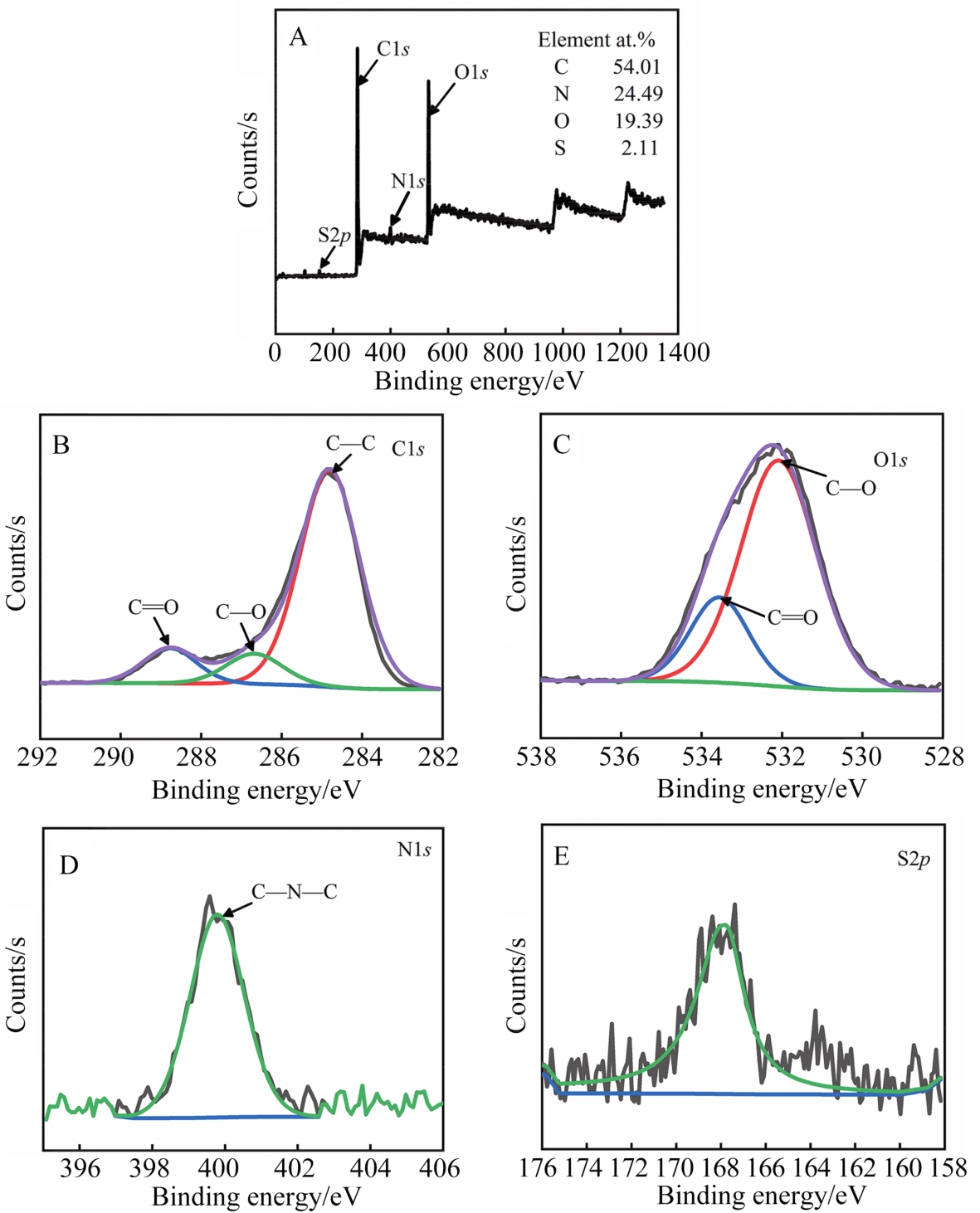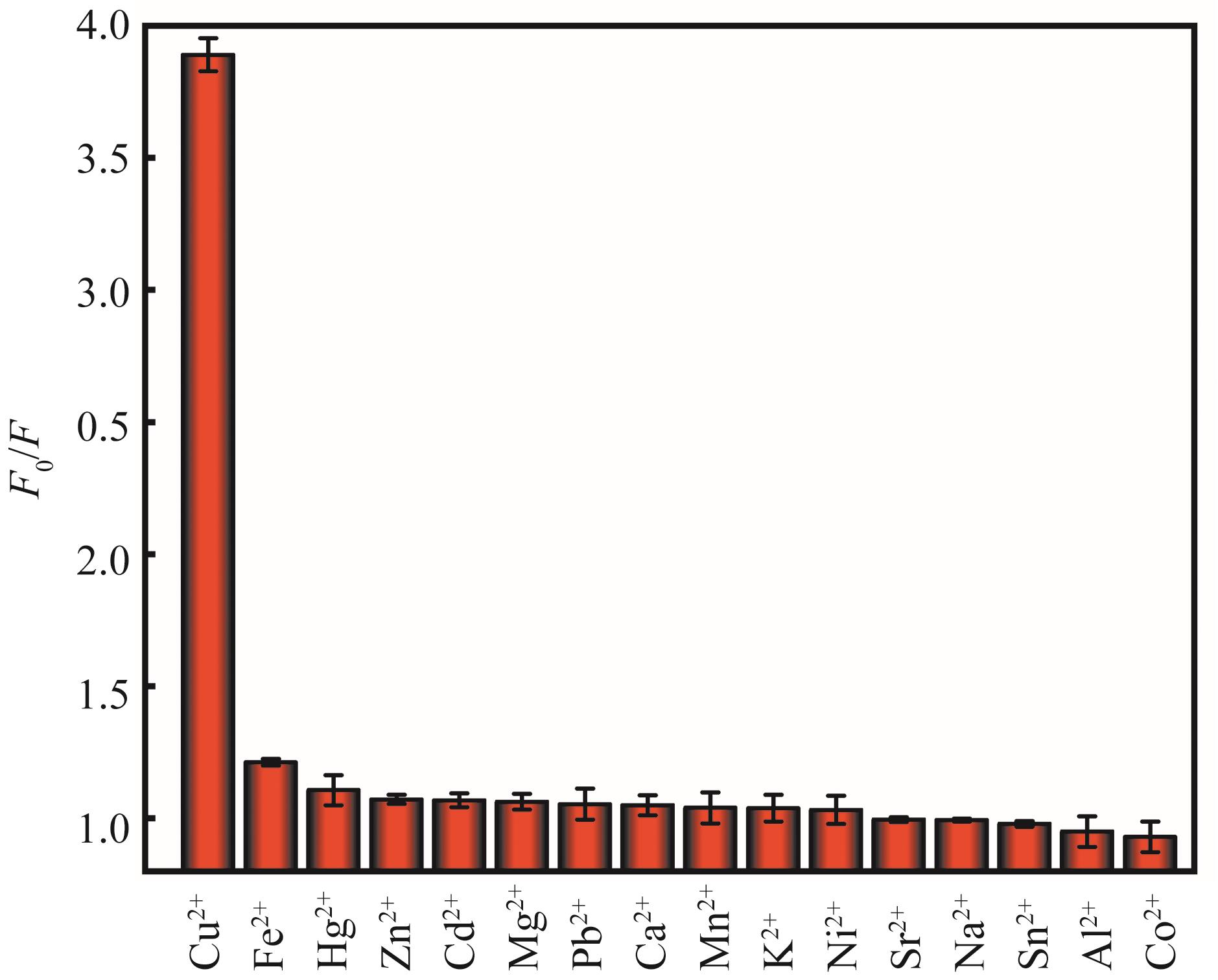
Chinese Journal of Applied Chemistry ›› 2022, Vol. 39 ›› Issue (6): 980-989.DOI: 10.19894/j.issn.1000-0518.210263
• Full Papers • Previous Articles Next Articles
Synthesis of Sulfur and Nitrogen Doped Carbon Dots for Cu(Ⅱ) Detection
Hai-Yan QI1( ), Chen-Qi ZHANG1, Jin-Long LI2, Jun LI3
), Chen-Qi ZHANG1, Jin-Long LI2, Jun LI3
- 1.Qiqihar University Institute of Chemical Engineering,Qiqihar 161006,China
2.Key Laboratory of Fine Chemicals of College of Heilongjiang Province,Qiqihar 161006,China
3.Heilongjiang Industrial Hemp Processing Technology Innovation Center,Qiqihar 161006,China
-
Received:2021-05-31Accepted:2021-09-27Published:2022-06-01Online:2022-06-27 -
Contact:Hai-Yan QI -
About author:E⁃mail:qhy120@sina.com
-
Supported by:the Fundamental Research Funds in Heilongjiang Provincial Universities(300882);the Program for Science and Technology of Qiqihar(GYGG?201903)
CLC Number:
Cite this article
Hai-Yan QI, Chen-Qi ZHANG, Jin-Long LI, Jun LI. Synthesis of Sulfur and Nitrogen Doped Carbon Dots for Cu(Ⅱ) Detection[J]. Chinese Journal of Applied Chemistry, 2022, 39(6): 980-989.
share this article

Fig.1 High resolution transmission electron microscopy(A), diameter size distribution curve(B), infrared spectrum (C) and X-ray electron diffraction spectrum (D) of NS-CDs
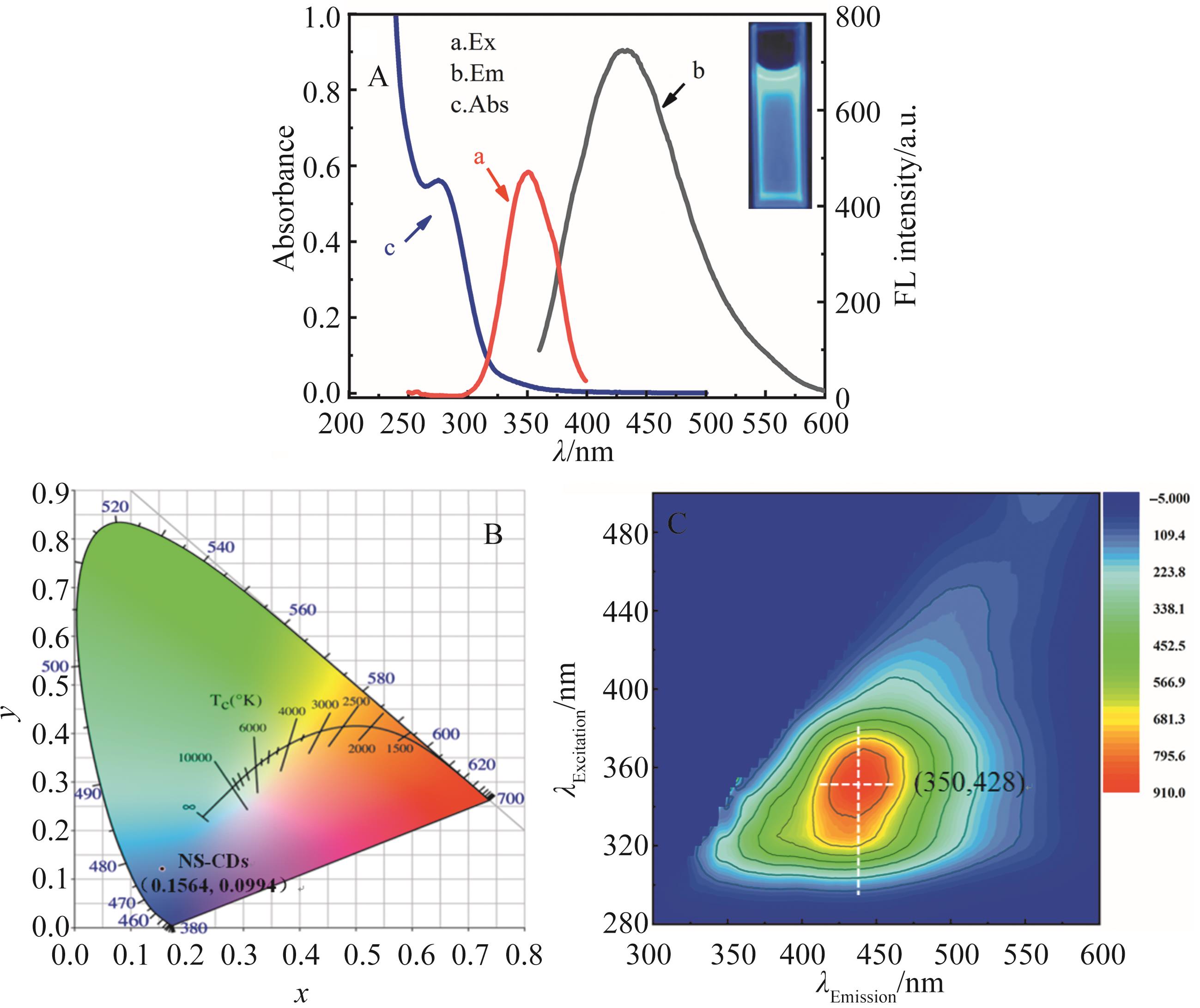
Fig.3 (A) Fluorescence emission (a), fluorescence excitation (b) and UV-Vis (c) spectra of NS-CDs. The illustration is the photo of NS-CDs under 365 nm ultraviolet; (B) The color coordinate spectrum of NS-CDs; (C) Excitation-emission matrix of NS-CDs
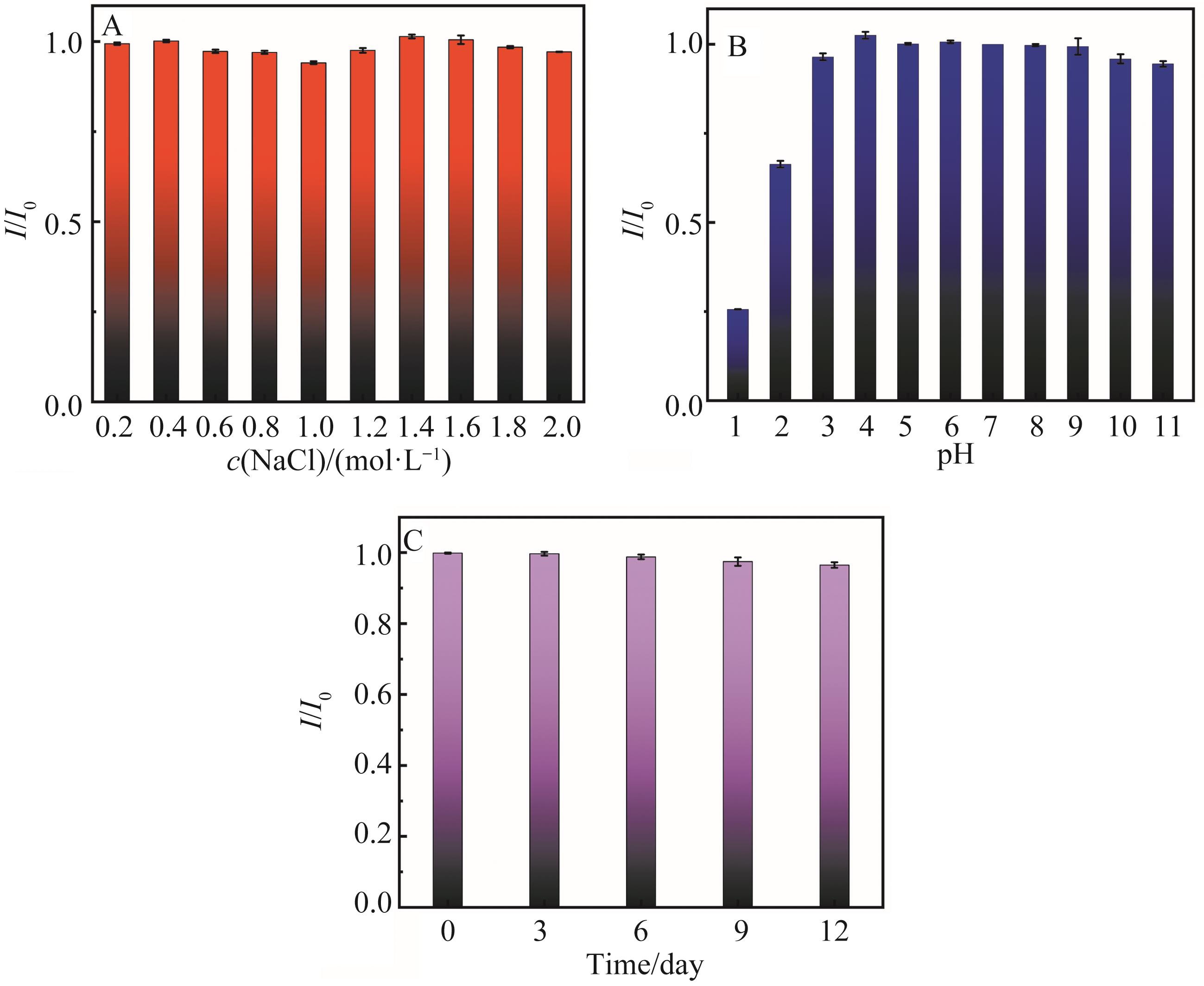
Fig.4 (A)Effect of different concentrations on the fluorescence intensity of NS-CDs; (B) The change of fluorescence intensity of NS-CDs at 428 nm excited by 350 nm with pH; (C) The relationship between NS-CDs fluorescence intensity and time under natural light

Fig.6 (A)Schematic illustration of detection of Cu2+ with NS-CDs; (B) UV-Vis spectra of NS-CDs upon addition of Cu2+ solutions, NS-CDs and separate Cu2+ solution; (C)Fluorescence response diagram of NS-CDs to Cu2+
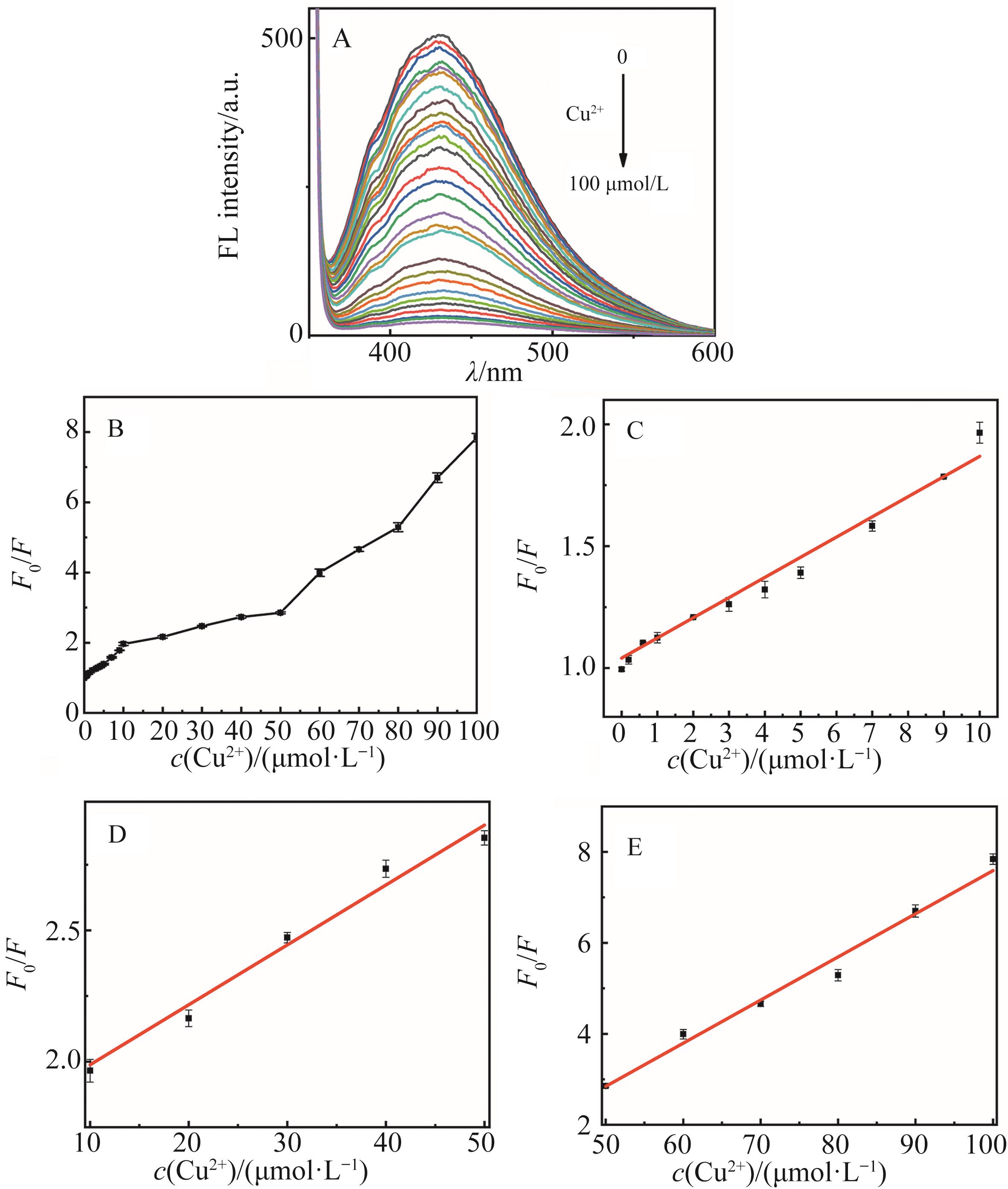
Fig.7 Changes of NS-CDs fluorescence emission spectra (A) with different concentrations of Cu2+=0, 0.2, 0.4, 0.6, 0.8, 1, 2, 3, 4, 5, 6, 7, 8, 9, 10, 20, 30, 40, 50, 60, 70, 80, 90 and 100 μmol/L (from top to bottom); (B) Change of fluorescence quenching degree of NS-CDs with different concentrations of Cu2+; (C,D,E) Linear curves of Cu2+ concentration and fluorescence intensity of gold clusters ( F and F0 stand for the fluorescence intensity of NS-CDs with and without Cu2+ in B, C, D and E, respectively)
材料 Materials | 线性范围 Linear range/(μmol·L-1) | 检出限 Detection limit/(nmol·L-1)) | 参考文献 Ref. |
|---|---|---|---|
| CMH?GA?CDs | 1~10 | 210 | [ |
| CDs | 10~100 | 132 | [ |
| NCDs | 0.4~200 | 125 | [ |
| PQDs | 0~280 | 4 740 | [ |
| CDs | 0~200 | 40 000 | [ |
| ND?CQDs | 0.3~30 | 190 | [ |
| NS?CDs | 0.2~100 | 41 | 本工作 This work |
Table 1 Comparison of performance of different fluorescence methods for detection of Cu2+
材料 Materials | 线性范围 Linear range/(μmol·L-1) | 检出限 Detection limit/(nmol·L-1)) | 参考文献 Ref. |
|---|---|---|---|
| CMH?GA?CDs | 1~10 | 210 | [ |
| CDs | 10~100 | 132 | [ |
| NCDs | 0.4~200 | 125 | [ |
| PQDs | 0~280 | 4 740 | [ |
| CDs | 0~200 | 40 000 | [ |
| ND?CQDs | 0.3~30 | 190 | [ |
| NS?CDs | 0.2~100 | 41 | 本工作 This work |
序号 No. | 初始值 Found/(μmol·L-1) | 加入值 Added/(μmol·L-1) | 测定值 Total found/(μmol·L-1) | 回收率 Recovery/% | 相对标准偏差 RSD(%, n=3) |
|---|---|---|---|---|---|
| 1 | 2.55 | 5.00 | 7.80 | 105.0 | 2.3 |
2 3 | 2.55 | 10.00 80.00 | 13.11 | 105.6 | 0.4 |
| 2.55 | 86.45 | 104.9 | 1.7 |
Table 2 Determination results of Cu2+ in real samples
序号 No. | 初始值 Found/(μmol·L-1) | 加入值 Added/(μmol·L-1) | 测定值 Total found/(μmol·L-1) | 回收率 Recovery/% | 相对标准偏差 RSD(%, n=3) |
|---|---|---|---|---|---|
| 1 | 2.55 | 5.00 | 7.80 | 105.0 | 2.3 |
2 3 | 2.55 | 10.00 80.00 | 13.11 | 105.6 | 0.4 |
| 2.55 | 86.45 | 104.9 | 1.7 |
| 1 | QIAN B, VÁRADI L, TRINCHI A, et al. The design and synthesis of fluorescent coumarin derivatives and their study for Cu2+ sensing with an application for aqueous soil extracts[J]. Molecules, 2019, 24(19): 3569. |
| 2 | MIAO X M, LING L S, CHENG D, et al. A highly sensitive sensor for Cu2+ with unmodified gold nanoparticles and DNA zyme by using the dynamic light scattering technique[J]. Analyst, 2012, 137(13): 3064-3069. |
| 3 | 安春, 杜佩瑶, 张振, 等. 基于谷胱甘肽修饰的金纳米簇选择性检测铜离子[J]. 分析化学. 2020, 48(3): 355-362. |
| AN C, DU P Y, ZHANG Z, et al. Rapid and highly selective detection of copper ion with glutathione-capped gold nanoclusters[J]. Chinese J Anal Chem, 2020, 48(3): 355-362. | |
| 4 | MANOJ K, NARESH K,VANDANA B. Ratiometric nanomolar detection of Cu2+ ions in mixed aqueous media: a Cu2+/Li+ ions switchable allosteric system based on thiacalix crown[J]. Dalton Trans, 2012, 41(34): 10189-10193. |
| 5 | 张嘉惠, 陈阳, 李静, 等. 基于表面增强拉曼光谱技术快速检测铜离子[J]. 分析化学, 2021, 49(3): 440-448. |
| ZHANG J H, CHEN Y, LI J, et al. Rapid detection of copper ions of simulated Wilson's disease urine based on surface-enhanced Raman spectroscopy[J]. Chinese J Anal Chem, 2021, 49(3): 440-448. | |
| 6 | CHAIYO S, CHAILAPAKUL O, SAKAI T, et al. Highly sensitive determination of trace copper in food by adsorptive stripping voltammetry in the presence of 1,10-phenanthroline[J]. Talanta, 2013, 108(8): 1-6. |
| 7 | 李夏楚秦, 杨通, 王健, 等. 基于CdTe量子点-电纺纳米纤维组装体可视化、便携检测铜离子[J]. 分析化学, 2021, 49(2): 207-215. |
| LI X C Q, YANG T, WANG J, et al. CdTe quantum dots-electrospun nanofibers assembly for visual and portable detection of Cu2+[J]. Chinese J Anal Chem, 2021, 49(2): 207-215. | |
| 8 | CINDY D, NAGAMALAI V, MARISA P, et al. Biocompatibility and bioimaging potential of fruit-based carbon dots[J]. Nanomaterials, 2019, 9(2): 199. |
| 9 | NEDA E, ZEINAB B, HAMIDE E, et al. Effect of carbonization degree of carbon dots on cytotoxicity and photo-induced toxicity to cells[J]. Heliyon, 2019, 5(12): e03038. |
| 10 | BINESH U, WU R S, WEI S C, et al. Fluorescent carbon dots for selective labeling of subcellular organelles[J]. ACS Omega, 2020, 5(20): 11248-11261. |
| 11 | YANG X X, CUI F C, REN R, et al. Red-emissive carbon dots for “Switch-On” dual function sensing platform rapid detection of ferric ions and L-cysteine in living cells[J]. ACS Omega, 2019, 4(7): 12575-12583. |
| 12 | WU J, WANG W J, WANG Z H. Porphin-based carbon dots for “Turn Off-On” phosphate sensing and cell imaging[J]. Nanomaterials, 2020, 12(2): 326. |
| 13 | ZHOU N, ZHANG X W, SHI Y P, et al. Nitrogen-doped carbon dots mediated fluorescent on-off assay for highly sensitive I- and Br- ions[J]. New J Chem, 2018, 42(17): 14332-14339. |
| 14 | STEFANIA L, MARTA A, ADALBERTO C, et al. Carbon nano-onions as fluorescent on/off modulated nanoprobes for diagnostics[J]. J Nanotechnol, 2017, 8: 1878-1888. |
| 15 | YANG R P, HU Y J, YANG S S, et al. Quantum-dot light-emitting diodes with nitrogen-doped carbon nanodot hole transport and electronic energy transfer layer[J]. Sci Rep, 2017, 7: 46422. |
| 16 | SUN X, LI H J, OU N Q, et al. Visible-light driven TiO2 photocatalyst coated with graphene quantum dots of tunable nitrogen doping[J]. Molecules, 2019, 24(2): 344. |
| 17 | YAN F Y, BAI Z J, CHEN Y, et al. Ratiometric fluorescent detection of copper ions using coumarin-functionalized carbon dots based on FRET[J]. Sens Actuator B, 2018, 275(1): 86-94. |
| 18 | PENG S S, JI H K, SANG J P. Celery Stalk-Derived carbon dots for detection of copper ions[J]. J Nanosci Nanotechnol, 2019, 19(6): 6077-6082. |
| 19 | WANG B G, TAN H, ZHANG T L, et al. Hydrothermal synthesis of N-doped carbon dots from an ethanolamine-ionic liquid gel to construct label-free multifunctional fluorescent probes towards Hg2+, Cu2+ and S 2 O 3 2 - [J]. Analyst, 2019, 144(9): 3013-3022. |
| 20 | LIU X R, ZHANG S X, XU H, et al. Nitrogen-doped carbon quantum dots from poly(ethyleneimine) for optical dual-mode determination of Cu2+ and L-cysteine and their logic gate operation[J]. ACS Appl Mater Interfaces, 2020, 12(42): 47245-47255. |
| 21 | HUANG S, ERLI Y, YAO J D, et al. Red emission nitrogen, boron, sulfur co-doped carbon dots for “on-off-on” fluorescent mode detection of Ag+ ions and L-cysteine in complex biological fluids and living cells[J]. Anal Chim Acta, 2018, 1035(4): 192-202. |
| 22 | LE T H, LEE H J, KIM J H, et al. Detection of ferric ions and catecholamine neurotransmitters via highly fluorescent heteroatom co-doped carbon dots[J]. Sensors, 2020, 20(12): 3470. |
| 23 | ZHAO L, WANG Y S, ZHAO X H, et al. Facile synthesis of nitrogen-doped carbon quantum dots with chitosan for fluorescent detection of Fe3+[J]. Polymers, 2019, 11(11): 1731. |
| 24 | ALI G, RAMA A B A, YOMEN A. Novel nitrogen-doped carbon dots prepared under microwave-irradiation for highly sensitive detection of mercury ions[J]. Heliyon, 2020, 6: e03750. |
| 25 | WU Z S, FENG M K, CHEN X X, et al. N-Dots as photoluminescent probe for rapid and selective detection of Hg2+ and Ag+ in aqueous solution[J]. J Mater Chem B, 2016, 4(12): 2086-2089. |
| 26 | 苗湘. 碳点的光学调控及其应用研究[D]. 中国科学院大学, 2018, 5. |
| MIAO X. Synthesis of carbons dots with tunable optical properties and their applications[D]. University of Chinese Academy of Sciences, 2018, 5. | |
| 27 | 陈芳, 朱丽华, 王宏. 碳点的制备及荧光量子产率的测定——一个仪器分析综合实验[J]. 大学化学, 2019, 34(7): 67-72. |
| CHEN F, ZHU L H, WANG H. Preparation of carbon dots and determination of their fluorescence quantum yield[J]. J Univ Chem, 2019, 34(7): 67-72. | |
| 28 | 刘杏芳, 杜华, 唐璜, 等. 土壤中重金属元素检测不同消解方法的比较[J]. 中国口岸科学技术, 2021, 9(3): 90-95. |
| LIU X F, DU H, TANG H, et al. Comparison of different digestion methods for detection of heavy metal elements in soil[J]. 2021, 9(3): 90-95. | |
| 29 | JORGE E C, ALFONSO F, MARTA E, et al. Smart carbon dots as chemosensor for control of water contamination in organic media[J]. J Pre-proof, 2020, 329: 129262. |
| 30 | JIAO Y, GAO Y F, MENG Y T, et al. One-step synthesis of label-free ratiometric fluorescence carbon dots for the detection of silver ions and glutathione and cellular imaging applications[J]. ACS Appl Mater Interfaces, 2019, 11(18): 16822-16829. |
| 31 | LÓPEZ-CABAÑAA Z, VALDÉSB O, VERGARAA C, et al. Photophysical studies of the interactions of poly(amidoamine) generation zero (PAMAM G0) with copper and zinc ions[J]. J Lumin, 2015, 164: 23-30. |
| 32 | 张筱烨. 聚酰胺⁃胺改性PVDF膜的制备及铜离子吸附研究[D]. 天津工业大学, 2019, 1. |
| ZHANG X Y. Preparation of polyamide-amine modified PVDF membrane and study on copper ion adsorption[D]. Tianjin Polytech University, 2019, 1. | |
| 33 | MADHURI B, SHREYA B, GAURAV V, et al. Water-dispersible fluorescent carbon dots as bioimaging agents and probes for Hg2+ and Cu2+ ions[J]. ACS Appl Nano Mater, 2020, 3(7): 7096-7104. |
| 34 | WANG L, LI M, LI W T, et al. Rationally designed efficient dual-mode colorimetric/fluorescence sensor based on carbon dots for detection of pH and Cu2+ ions[J]. ACS Sustainable Chem Eng 2018, 6(10): 12668-12674. |
| 35 | ZHAO L, LI H Y, XU Y, et al. Selective detection of copper ion in complex real samples based on nitrogen-doped carbon quantum dots[J]. Anal Bioanal Chem, 2018, 410(18): 4301-4309. |
| [1] | Ming-Yan LIU, Xiu-Ding SHI, Tian-Guo LI, Jing WANG. Research Progress in Detection of Heavy Metal Ions by Electrochemical Analysis [J]. Chinese Journal of Applied Chemistry, 2023, 40(4): 463-475. |
| [2] | Yue-Xia ZHANG, Xiao-Peng FAN, Yu-Juan CAO, Xin-Tong YANG, Zhong-Ping LI, Zhen-Hua YANG, Chuan DONG. Synthesis of Oil-soluble Carbon Quantum Dots by Pyrolysis Method for the Detection of Oxytetracycline [J]. Chinese Journal of Applied Chemistry, 2023, 40(4): 509-517. |
| [3] | Shi-Peng JIANG, Yu-Xi ZHOU, Pei-Ran MENG, Yan-Xuan XIE, Zhi-Yi SONG, Huan-Ying ZHAO, Yue SUN. Preparation and Properties of Ultramicro Imprinting Sensor for Human Serum Albumin via Metal-free Visible-light-induced Atom Transfer Radical Polymerization [J]. Chinese Journal of Applied Chemistry, 2023, 40(2): 299-308. |
| [4] | Rui-Zhe WANG, Guang-Qi HU, Wei-Hao YE, Chao-Fan HU, Jian-Le ZHUANG, Bing-Fu LEI, Wei LI, Ying-Liang LIU. Hydrothermal Preparation and Application of Oil-soluble Carbon Dots with High Ultraviolet-short-wave Blue Light Shielding [J]. Chinese Journal of Applied Chemistry, 2023, 40(1): 59-68. |
| [5] | Zhen-Hua YANG, Xuan-Sen SUN, Yue-Xia ZHANG, Yu-Juan CAO, Qi-Qi ZHANG, Qiao-Zhi GUO, Xiao-Peng FAN, Zhong-Ping LI, Chuan DONG. Preparation of Nitrogen Sulfur Co⁃doped Carbon Dots with Nitrogen Sulfur and the Application for Detection of Oxytetracycline in Milk [J]. Chinese Journal of Applied Chemistry, 2022, 39(9): 1382-1390. |
| [6] | Wen-Dong WANG, Zai-Jun LI. Synthesis of Ruthenium‑Graphene Quantum Dots Artificial Oxidase and Its Application in Colorimetric Detection of Phoxim in Carrots [J]. Chinese Journal of Applied Chemistry, 2022, 39(8): 1285-1293. |
| [7] | Lian-Bo TANG, Da-You FU, Qi CHEN, Yang-Run FENG, Ya-Lin XIONG, Zhu-Qing WANG. Enhanced Gas⁃Liquid Chemiluminescence by Carbon Dots for Determination of Carbon Dioxide [J]. Chinese Journal of Applied Chemistry, 2022, 39(8): 1294-1302. |
| [8] | Feng-Zhou XU, Hua-Ying TANG, Wu-Hui LIU, Yi-Feng JIANG, Wen-Kai LI, Xian-Hai LU. A Visual Semi⁃quantitative Method for Rapid Detection of Copper Ion in Water [J]. Chinese Journal of Applied Chemistry, 2022, 39(8): 1303-1311. |
| [9] | Dong-Dong LI, Li QIN, Lu-Hua TANG, Wen-Hui GAO. Preparation and Application of Basic OrangeⅡImprinted Sensor [J]. Chinese Journal of Applied Chemistry, 2022, 39(7): 1052-1064. |
| [10] | Qing-Fang NIU, Xin AI, Yi-Xuan WANG, Fang-Jiu HE, Bi LUO, Wen-Ting LIANG, Chuan DONG. Synthesis of Three‑Dimensional Reduced Graphene Oxide/β‑Cyclodextrin Complex and Its Electrochemical Detection of Levofloxacin in Water [J]. Chinese Journal of Applied Chemistry, 2022, 39(7): 1129-1137. |
| [11] | Xiao-Li ZHANG, Yu-Mei PENG, Qing-Wei WANG, Li-Xia QIN, Xiao-Xia LIU, Shi-Zhao KANG, Xiang-Qing LI. Construction of Nano Ag Modified TiO2 Nanotube Array Substrate for Surface Enhanced Raman Scattering Detection and Degradation of Tetracycline Hydrochloride [J]. Chinese Journal of Applied Chemistry, 2022, 39(7): 1147-1156. |
| [12] | Zhen-Hua LI, Ying ZHU, Jing CHEN, Shi-Ping SONG. Advances in Construction and Electrochemical Biosensing of Antifouling Interfaces [J]. Chinese Journal of Applied Chemistry, 2022, 39(5): 736-748. |
| [13] | Tao WANG, Sha LIU, Bao-Lin LIU, Zhi-Xian GAO. Application of Biosensors Based on Aptamers and Antibodies in the Detection of Estradiol [J]. Chinese Journal of Applied Chemistry, 2022, 39(3): 374-390. |
| [14] | Li QIN, Xiao-Ting YOU, Lu-Hua TANG, Jian-Wen LI, Yin ZHANG, Wen-Hui GAO, Jun-Hua HAN. Preparation and Application of Auramine O Imprinted Sensor Based on Nanomaterials Modification [J]. Chinese Journal of Applied Chemistry, 2022, 39(12): 1880-1890. |
| [15] | Jin-Ping SONG, Qi MA, Xiao-Min LIANG, Jian-Peng SHANG, Chuan DONG. Neodymium and Nitrogen Co‑doped Carbon Dots with High Fluorescence Quantum Yield for Detection of Sulfasalazine and Hela Cell Imaging [J]. Chinese Journal of Applied Chemistry, 2022, 39(11): 1726-1734. |
| Viewed | ||||||||||||||||||||||||||||||||||||||||||||||||||
|
Full text 1307
|
|
|||||||||||||||||||||||||||||||||||||||||||||||||
|
Abstract 659
|
|
|||||||||||||||||||||||||||||||||||||||||||||||||
